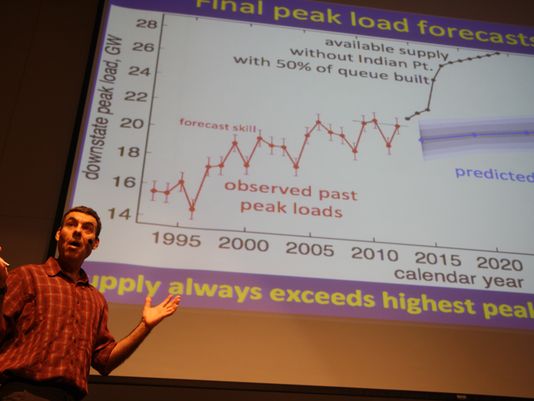ANNANDALE – Bard College research professor of environmental science and physics Gidon Eshel, Ph.D., an independent geophysicist, spoke at Bard College earlier this month to showcase his findings that existing power lines can meet our region's peak electricity-demand needs well into the future.
The presentation was hosted by members of the Hudson Valley Smart Energy Coalition, a collaboration of community groups and officials partnered with Scenic Hudson in working to protect Hudson Valley communities from potential negative effects of new high-voltage power lines. The state's Public Service Commission is seeking to expand 150 miles of transmission lines that would pass through seven counties and 25 towns in the valley, ultimately reaching their destination in Dutchess County.
More than 250 people attended the presentation in the Bertelsmann Campus Center. Eshel told the group that existing infrastructure can handle downstate peak power loads until at least 2040. He devoted more than 350 hours over the summer to the research, analyzing data on mean and peak energy usage, electricity congestion, climate trends and regional demographics. His preliminary analyses have led him to three key variables determining downstate peak loads: total downstate population, annual maximum temperatures and population age distribution.
"There's simply no need for the proposed power lines at any time between now and 2040. The population rise in New York is not continuing at the pace that it has historically exhibited. In addition, the ratio of those ages 25 to 45 to those ages 45 to 70 has been steadily declining in recent decades, but this is expected to reverse in coming decades," Eshel said, according to a news release, "which is important because the young use less energy per capita than the middle aged. Even assuming no energy efficiency gains or renewable energy proliferation, you still see no need for this project."
A geophysicist with expertise in data analysis and efficiency metrics, Eshel took on the project as an independent researcher. His property could be affected by the proposed power lines, so he was motivated as a credentialed professional researcher to prepare a scientific analysis of the consumer-demand issue. While Eshel is not a member of the Hudson Valley Smart Energy Coalition, members of the coalition were at the presentation to provide information about the proposed high-voltage power lines and how citizens can be involved in the regulatory review process.
"The Energy Highway threatens the Hudson Valley's beauty and farmland with towering new transmission lines," Scenic Hudson President Ned Sullivan said in a news release. "Governor Cuomo has launched another initiative to reform New York's power grid through innovation and conservation. Gidon Eshel's compelling presentation shows new transmission lines are not needed. As a result, we can immediately begin the transition to a 21st-century energy system, putting New York in the national vanguard and saving the beauty and economy of the Hudson Valley."
The presentation was hosted by members of the Hudson Valley Smart Energy Coalition, a collaboration of community groups and officials partnered with Scenic Hudson in working to protect Hudson Valley communities from potential negative effects of new high-voltage power lines. The state's Public Service Commission is seeking to expand 150 miles of transmission lines that would pass through seven counties and 25 towns in the valley, ultimately reaching their destination in Dutchess County.
More than 250 people attended the presentation in the Bertelsmann Campus Center. Eshel told the group that existing infrastructure can handle downstate peak power loads until at least 2040. He devoted more than 350 hours over the summer to the research, analyzing data on mean and peak energy usage, electricity congestion, climate trends and regional demographics. His preliminary analyses have led him to three key variables determining downstate peak loads: total downstate population, annual maximum temperatures and population age distribution.
"There's simply no need for the proposed power lines at any time between now and 2040. The population rise in New York is not continuing at the pace that it has historically exhibited. In addition, the ratio of those ages 25 to 45 to those ages 45 to 70 has been steadily declining in recent decades, but this is expected to reverse in coming decades," Eshel said, according to a news release, "which is important because the young use less energy per capita than the middle aged. Even assuming no energy efficiency gains or renewable energy proliferation, you still see no need for this project."
A geophysicist with expertise in data analysis and efficiency metrics, Eshel took on the project as an independent researcher. His property could be affected by the proposed power lines, so he was motivated as a credentialed professional researcher to prepare a scientific analysis of the consumer-demand issue. While Eshel is not a member of the Hudson Valley Smart Energy Coalition, members of the coalition were at the presentation to provide information about the proposed high-voltage power lines and how citizens can be involved in the regulatory review process.
"The Energy Highway threatens the Hudson Valley's beauty and farmland with towering new transmission lines," Scenic Hudson President Ned Sullivan said in a news release. "Governor Cuomo has launched another initiative to reform New York's power grid through innovation and conservation. Gidon Eshel's compelling presentation shows new transmission lines are not needed. As a result, we can immediately begin the transition to a 21st-century energy system, putting New York in the national vanguard and saving the beauty and economy of the Hudson Valley."


 RSS Feed
RSS Feed
